All the times we missed the orcas passing the Lime Kiln during our land-based research were about to be made up for…
Once we were aboard our catamaran home, our lives could basically revolve around the movement of the orcas, and it didn’t take long for that to begin. Since we started taking data on the whales right from day one, we had to take what we had learnt at the Lime Kiln and adapt quickly to data recording at sea.
“Permission to Deploy the Arrayâ€:
Once the whales were around us, we would deploy a four hydrophone array from the back of the boat and start recording. Laura listened to the calls and clicks being recorded in one minute time segments and recorded what she could hear on a phonation sheet so we could go back and listen to the best recordings afterwards. We also played the hydrophones through the speakers throughout the catamaran, so even those of us not working on the acoustics could have the full effect while we were with the whales.
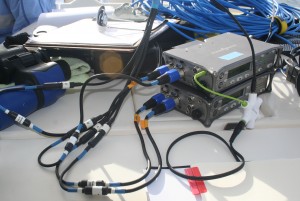
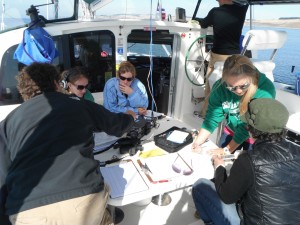
The hydrophone array recording equipment (left) and the team preparing to record the whales on our first day (right).
“Two whales, 12 o’clock, 200 meters, traveling North!â€:
Sharon and I were on behaviour lookout. The idea was to call out every whale we saw with a clock bearing, a distance, and what activity they were doing, while Hayley wrote all this information down on a behaviour sheet. We were also specifically recording surface active behaviours (such as tail slaps and breaches) and foraging behaviour for our own projects. Sounds simple enough, but when you have anywhere from 5 to 50 whales in sight, 360 degrees around the boat, things got pretty crazy (but crazy in the best way possible, this is what we were here for!).
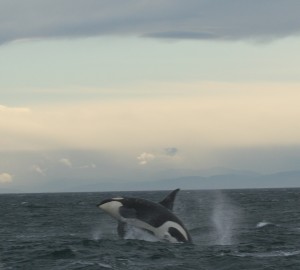
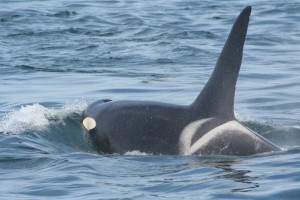
An orca breaching (left) and J26 – “Mike” swimming past the Gato Verde (right) during our data collection.
Since Beam Reach 112 had some of the most orca encounters while out on the water, this routine was continuously practiced and fine tuned, but every so often there were days without orcas where we could experiences some other aspects of life at sea.
While the orcas are away:
One of our other main focuses while living at sea was learning about sailing. We had lessons beginning with all the basic parts of a sail boat, and progressing through raising the sails, choosing an appropriate sailing course, steering, tacking and jibing, and learning the right of way rules. It was great experience going through all the steps required in order to sail, and to help eachother learn along the way. We even had the opportunity to sail with some near gale-force gusts making it all the more exciting.
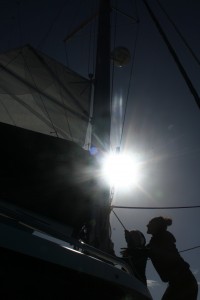
Preparing to raise the main sail
We also quite often had some other playful cetaceans visit us while the orcas were out at sea. Dall’s porpoises would bow-ride infront of us, most often near the Lime Kiln. We would lie on the front on the boat and watch them swimming just a couple feet below us. Some would even turn on their sides to get a better look at us and then come up to give us a splash, seemingly on purpose. We even thought we could hear them clicking on our “listening hydrophone” we had deployed one day as they approached our stationary boat.
Dalls Porpoises Bow-Riding the Gato Verde
Other research we conducted while the orcas were away included CTD casts, which took the whole team to lower the CTD (an instrument used to obtain a depth profile of temperature, salinity, and various other water measurements) 60 meters into the water, and then use a winch to crank it back onto the boat. I also fished for salmon and analyzed fish finder data from the boat for my project while the orcas we away, and had great success doing so!
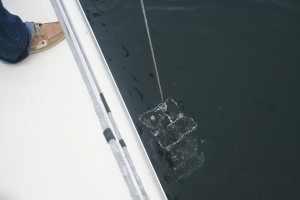
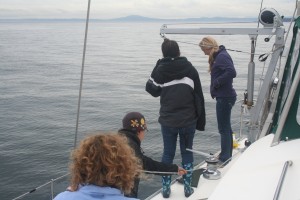
The CTD in the water (left) and the crew waiting to haul it back up (right)
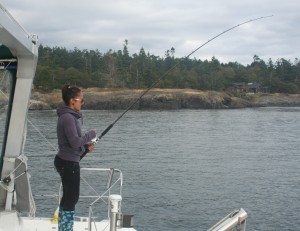
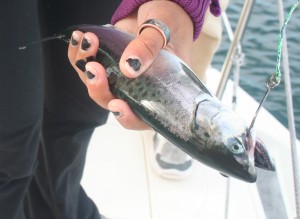
Salmon fishing off the boat (left) and a successful catch of a juvenile Chinook (right).
Read More
Learning about the ecosystem an organism belongs to is often just as important as learning about the organism itself, so that’s what Beam Reach 112 set out to do for the first few weeks on land. We were fortunate enough to be able to set up our land based research at the Lime Kiln lighthouse where the orcas are seen frequently (usually!). Though the orcas managed to elude us the majority of the time we were at the lighthouse, we had no shortage of research we could do.
Marine Mammal and Bird Observing:
Each day at the lighthouse, one person was on observation. For 45 minutes at a time, every bird and mammal spotted was recorded. Seagulls, Cormorants, Murres, Dall’s porpoises, Harbour porpoises, and playful seals were regulars at the lighthouse on pretty much a daily basis.
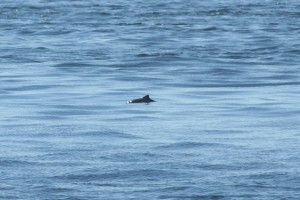
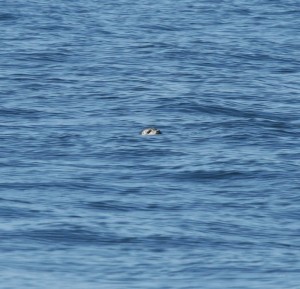
Harbour porpoise and a peeking seal observed from the platform infront of the Lime Kiln lighthouse.
Underwater Camera Monitoring:
An underwater splashcam was installed directly infront of the lighthouse with the first hydrophone and the, also newly installed, CPODs (for detecting dolphin and porpoise clicks) in view. One person’s duty was to record everything that swam infront of the splashcam on paper and as 10 minute video recordings. We often had kelp greenlings and rockfish hanging around in view, taking the occasional nap ontop of the CPODs, or swimming up to give the camera a big kiss. We also got footage of the occasional large lingcod, seals swimming past, and schools of salmon swimming north (headed for the Fraser River?).
Salmon school swims past splashcam at LK lighthouse
Water Analysis:
Using a YSI monitor, two people recorded water temperature, salinity, and dissolved oxygen daily. Then they also took a plankton tow and attempted to identify as many species as possible. The average water temperature was 10.85°C, average salinity was 28.95ppt, and average dissolved oxygen was 6.25mg/L. Some of the most commonly identified plankton species were Chaetoceros, Cylindrotheca, and Skeletonema.
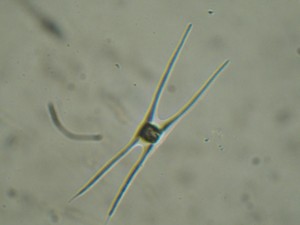
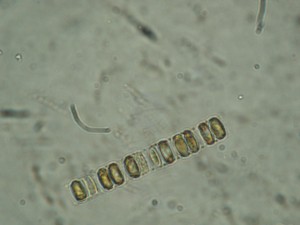
Chaetoceros (left) and Skeletonema (right) found in samples collected at the Lime Kiln lighthouse.
Orcas!
When we finally caught the orcas swimming past the lighthouse, we were ready to spring into action. One person started recording and monitoring the hydrophones. Audible calls and clicks were recorded on a phonation sheet so that we could go back and listen to the best times of the audio recordings. The other three of us headed down to the “iron post†infront of the
lighthouse, armed with a behaviour sheet, binoculars, and the camera. The goal was to record clock orientation (to the iron post), travel direction, distance, and any surface active behaviours, and attempt to get as many identification pictures as possible. This information goes into the Beam Reach archives to help with future projects, and can be used to help us confirm localizions of calls from the hydrophone recordings.
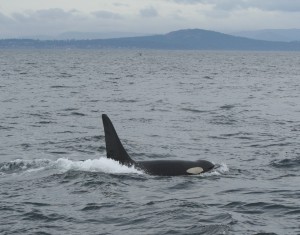
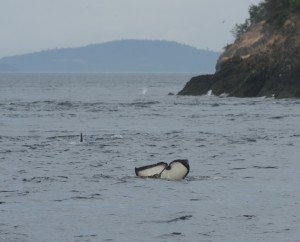
Orcas passing by the Lime Kiln lighthouse on September 15, 2011
Our time at the Lime Kiln helped us learn about the “big picture” of all the pieces of the orcas’ environment. Though it was kind of hectic (yet extremely exciting) when we did get to record orca data, it gave us a good introduction to what life on the Gato Verde would be like…
Read More
Fish hatcheries have become ever more important in recent years due to the declines in wild stocks. The aim of hatcheries is to replenish the wild stock in order to keep the fishing industry sustainable, but there is still debate as to what is the best approach to this without causing further damage to the wild population. In an attempt to make improvements to hatchery practices, Hitoshi Araki studied the reproductive success of hatchery trout compared to wild trout, and made suggestions in his paper Hatchery Stocking for Restoring Wild Populations: A Genetic Evaluation of the reproductive Success of Hatchery Fish vs. Wild Fish (2008).
The hypothesis was that fish bred using the traditional hatchery methods, in which the fish are usually non-local and are bred for many generations in captivity, have much lower reproductive success than both supplemental hatchery fish and wild fish. The idea behind supplemental hatchery methods is to use local parent fish to breed “wild stock” hatchery fish in a protected environment, and then release them into the wild population, with the overall goal being to re-create a sustainable wild population. Using DNA analysis of steelhead trout from the Hood River, Araki determined the reproductive success of traditional hatchery fish, supplemental hatchery fish, and wild fish. He found that the more generations bred in a hatchery, the less reproductively successful the fish are.
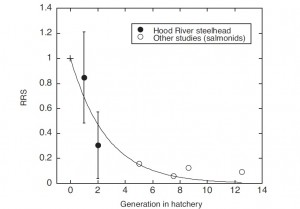
Picture 1: Araki used his own data and data from previous studies to show the decline in relative reproductive success (RRS) as the number of generations in a hatchery increased.
Araki also found that supplemental hatchery fish had significantly higher reproductive success than the traditional hatchery fish, though they still had lower reproductive success than the wild population. When a wild stock parent was crossed with a traditional hatchery parent the reproductive success dropped. This shows the effect that hatchery fish can have on the wild population. If traditional hatchery fish continue to be released into wild populations in attempt to sustain them, they will continue to lower the reproductive success of the wild population.
It seems that, though hatcheries have a positive sustainability goal in mind, the traditional methods they are using to replenish wild stocks are somewhat counter-acting what they are trying to achieve. Though it may be more work to implement supplemental hatchery methods, the benefit of higher reproductive success of the population should be worth it.
Araki used steelhead trout as his example organism, but it is assumed that similar principles could apply to other fish species. In the San Juan and Vancouver Island area, salmon hatcheries are an important part of the fishing industry (and produce important food for the Southern resident orcas!). Since Chinook salmon are endangered in the area, a large amount of juveniles are released into the wild from hatcheries. From the information I could find, it seemed hatcheries in the area are attempting to use methods closer to supplemental techniques rather than the traditional methods. For example, the San Juan Enhancement Society in Port Renfrew, BC collect their broodstock (parent fish) of Chinook from a lake connecting to the San Juan River, therefore the juvenile fish are being released into their natural habitat. Though it isn’t stated how many generations are produced in the hatchery, it still could be considered a step in the right direction compared to using a non-local broodstock. Hopefully in the future hatcheries move towards supplemental practices so that the wild stocks, the ecosystem, and everyone utilising the fish can further benefit from sustainable fish populations.
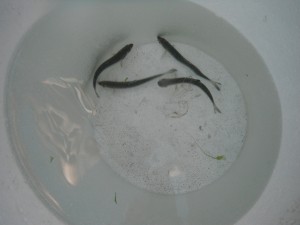 Picture 2: Both wild and hatchery juvenile Chinook can be found in the San Juan Islands, as our Beam Reach class found out while beach seining on Lopez Island. The hatchery salmon had their fins clipped for identification.
Picture 2: Both wild and hatchery juvenile Chinook can be found in the San Juan Islands, as our Beam Reach class found out while beach seining on Lopez Island. The hatchery salmon had their fins clipped for identification.
Read More
After working out what sustainability science is, and all of the different fields it incorporates, I chose to focus on the fishing industry and what attempts it is making to be on a sustainable path, after large declines in many fish stocks, as my case study example. I chose a paper by Daniel Pauly et al. called Towards Sustainability in World Fisheries (Nature, 2002). This article reviews the practices of the fishing industry in the past, what they have begun to do to achieve sustainability, and what is needed in the future to try to enforce sustainability practices.
In the 1950s and 1960s, the fishing industry began growing rapidly around the world. Within 10 to 15 years of this rapid growth, and increase in government encouragement to make more catches, public examples of fish stocks crashing began to surface. What I found shocking while reading this paper was that, even though there were clear examples of depletions in fish populations (ie. cod populations in eastern Canada), the fishing industry had already become so huge that there was always an acceptable excuse to let fishing continue in the same manner around the world. Often times declines were blamed on “unspecified environmental change”, and it was also recently discovered that the People’s Republic of China had been over-reporting their catches, changing the statistics of how much global fish stocks had been declining since approximately the 1980s.
Since fishing became a large global industry, there has been some sort of monitoring of the fish stocks, in some attempt to preserve sustainability. Single-species assessments were traditionally being used and more sophisticated versions are still in practice, but as Pauly et al. explained, there have been some flaws in this approach which have led this system to fail. The problems include underestimating the severity of stock declines, and the failure to put short-term management of the stocks in place. There are also other impacts that the fishing industry is having that have not fully been taken into account when putting sustainability management in place. Depletion of the target fish species is also having an impact on the rest of the ecosystem.  Food webs in the marine environment are being disrupted with the removal of species in the mid-trophic levels, and rather than focusing on single species, ecosystems as a whole should be considered when working on sustainability management. There is also an issue with “overcapitalization” of fisheries, partly due to allowing increase in fishing vessel size, governments paying subsidies to fishers, and different types of fisheries with different rules that are not being closely monitored.
As more of the issues with the fishing industry have come to light, there has been a bigger focus on aquaculture (ie. fish farms) which many believe could be the solution to depleted wild fish stocks, but Pauly et al. point out some potential issues with this solution aswell. I was surprised to learn that aquaculture operations are actually using a lot of natural resources, and even more surprised to learn that they are even using wild stock fish to operate. Some aquaculture operations fatten their carnivorous fish with fish meal, which is actually made out of ground up fish such as herring!
Unfortunately, it seems to me that the fishing industry is still headed towards an unsustainable and grim future after reading the majority of this paper, but Pauly et al. do provide some hope near the end. Though there is still a lot of work to be done from a management standpoint, Marine Protected Areas (MPAs) that have a “no-take” policy have already shown to help increase depleted fish stocks that fuel the fishing industry. This is shown in the image below where Pauly et al. are comparing unexploited fish stocks with exploited stocks with and without no-take reserves. There are now fish scientists working feverishly around the world to gather data and plead their case for MPAs to be set up and well protected. 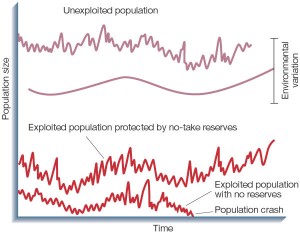
A maybe less likely goal is to begin downsizing and decomissioning some commericial fishing fleets so that there is simply less fishing occuring. Since the demand for fish is so high, this would be a hard plan to begin implementing, but it deserves serious consideration in the future if the fish stocks continue to decline.
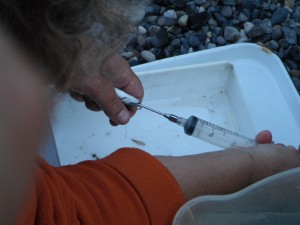 This week my classmates and I were fortunate enough to get a glimpse into the world of fish research when we helped out a group studying the endangered chinook salmon population in the San Juan area. This fit in perfectly with my case study since the chinook stocks are very low, and they are also being hatched in hatcheries to try to improve the stocks (we managed to catch one hatchery fish, which are marked before they are released). The data being collected included a fin biopsy and preserving the stomach contents to analyze what the juveniles are eating. This is the type of biological research the makes a large contibution to sustainability science and gives hope to the future of global fish stocks.
This week my classmates and I were fortunate enough to get a glimpse into the world of fish research when we helped out a group studying the endangered chinook salmon population in the San Juan area. This fit in perfectly with my case study since the chinook stocks are very low, and they are also being hatched in hatcheries to try to improve the stocks (we managed to catch one hatchery fish, which are marked before they are released). The data being collected included a fin biopsy and preserving the stomach contents to analyze what the juveniles are eating. This is the type of biological research the makes a large contibution to sustainability science and gives hope to the future of global fish stocks.
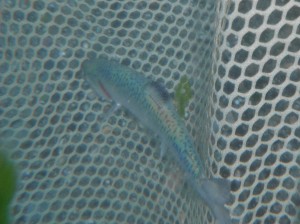
Read More
On our first day of Beam Reach fall 2011 sustainability science class, we were asked what seemed to be a rather simple question: “What is the definition of sustainability science?”. When we went to put our pens to paper we quickly discovered that this seemingly simple question really had no simple answer. My initial definition was “Using scientific research and methods to improve the sustainability of natural resources”. My classmates had varying degrees of similar answers, but it led to the question: what is sustainability science REALLY?
The very simple definition that Val gave us seemed to lead us on the right track: “A quest for basic knowledge that could be used in a very practical way”. It is the science that starts at the very basics of how ecosystems work, and then links many different parts of our world. It involves finding a balance between meeting human needs and preserving the natural way that the ecosystems providing for us work. There is a huge overlap of different fields that contribute to creating sustainability science, as depicted by the National Academy of Sciences in the book Our Common Journey: A Transition Towards Sustainability (1999):
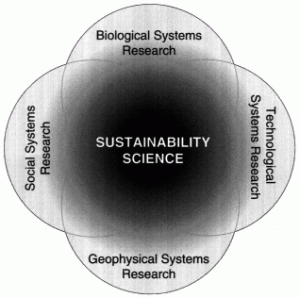
This diagram shows how four areas of research all contribute to the sustainability science field. First, biological science research is used in order to understand  the natural systems in which we are utilising and affecting. Technological systems research is used to determine the technological advancements that can be made to move towards a goal of sustainability. Geophysical systems research is used to determine how we are affecting the earth in terms of climate and geography, which in turn could potentially affect the biological systems in which we are utilising. Finally, social systems research is used to assess society’s values and points of view towards human impact on the earth’s systems.
After putting some more thought into the idea of sustainability science, I realized how big of a challenge is it for us as a society to move towards a sustainable way of life. It not only involves different aspects of science, but it also involves political and social aspects, and it is inevitable that the parties involved will have disagreements on the best approach given their differences in point of view.
Sustainability science is a rather simple term that is becoming ever more commonly used in today’s society, but don’t be fooled, it is deceivingly complicated, but will be well worth the effort in the future if we are able to stay on a path to a sustainable way of life, where we have less impact on the earth and are able to find the balance between our needs and preserving natural systems for generations to come.
Read More
























 Twitter
Twitter LinkedIn
LinkedIn Facebook
Facebook